Rehiyon kan Filipinas
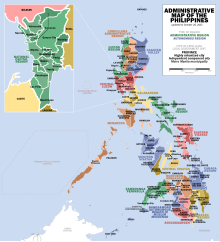
Sa Filipinas, an mga rehiyon (Filipino: rehiyon; ISO 3166-2:PH) iyo an mga administratibong dibisyon na pangenot na nagseserbe sa pagkoordina nin pagplano asin pagkaorganisar kan mga serbisyo kan nasyonal na gobyerno sa ibong kan dakolon na lokal na yunit nin gobyerno (LGUs). An kadaklan na opisina nin gobyerno nasyonal nagtatao nin serbisyo sa paagi kan saindang mga sanga rehiyonal imbes na magkaigwa nin direktang mga opisina probinsyal o siyudad. An mga opisina sa rehiyonal parate alagad bako man talaga yaon sa siyudad na pigdesignar bilang rehiyonal na sentro.
Poon kan 2019, nababanga an Filipinas sa 17 rehiyon. 16 kaini mga administratibo sanang paggugrupo-grupo, lambang saro itinatao kan presidente kan Filipinas na may rehiyonal na konseho nin pagtalubo (RDC) — sa kaso kan National Capital Region (Metro Manila), sarong dugang na metropolitan awtoridad an nagseserbing koordinado asin autoridad na nagseserbi bilang nagkokoordinar asin hawak na tagagibo nin polisiya. Solamenteng saro sana, an Autonomong Rehiyon nin Bangsamoro sa Muslim Mindanao, igwang elehidong gobyerno asin parlamento na kun saen iniliher kan kongreso kan Filipinas an nagkapirang mga poder asin responsibilidad.
Kasaysayan
[baguhon | baguhon an source]Enot na naglataw sa eksistensya an mga rehiyon kaidtong Setyembre 24, 1972, kan an mga probinsya kan Filipinas inaorganisar sa kagsarong rehiyon sa irarom kan Presidential Decree No. 1 bilang kabtang kan Integrated Reorganization Plan ni Presidente Ferdinand Marcos.[1] Poon kan panahon na iyan, an ibang mga rehiyon linalang asin an ibang mga probinsya ilinipat gikan sa sarong rehiyon pasiring sa iba pa.
Pagkasunodsunod kan mga pangyayari
[baguhon | baguhon an source]- Hunyo 22, 1973 – Ilinipat an Pangasinan gikan sa Central Luzon (Region III) pasiring sa Ilocos Region (Region I).[2]
- Hulyo 7, 1975 – Linalang an Rehiyon XII, asin inorganisar giraray an iba pang mga rehiyon kan Mindanao.[3]
- Hulyo 25, 1975 – Dineklara an mga Rehiyon IX asin XII bilang mga Awtonomong Rehiyon sa Solnopan asin Central Mindanao, respectively.[4]
- Agosto 21, 1975 – Binangâ an Rehiyon IX sa Sub-Rehiyon IX-A asin Sub-Rehiyon IX-B. Inorganisar giraray an ibang mga rehiyon sa Mindanao.[5]
- Nobyembre 7, 1975 – Linalang an Metro Manila.[6]
- Enero 23, 1976 – Siniblag an Metro Manila sa Habagatan na Tagalog tanganing magin Rehiyon IV; an Habagatan na Tagalog nagin Rehiyon IV-A.[7]
- Hunyo 2, 1978 – Dineklara an Metro Manila bilang National Capital Region.[8]
- Hunyo 11, 1978 – An regional center kan Rehiyon IX ilinipat gikan sa Jolo, Sulu, pasiring sa Zamboanga City.[9]
- Hulyo 15, 1987 – Linalang an Cordillera Administrative Region.[10]
- Agosto 1, 1989 – Linalang an Autonomous Region in Muslim Mindanao (ARMM).[11] Region XII reverted to an administrative region.
- Enero 30, 1990 – Sinayumahan kan mga residente kaidtong plebisito an ratipikasyon na lalangon an Cordillera Autonomous Region.[12]
- Oktobre 12, 1990 – Inisyu an Executive Order No. 429 ni Presidente Corazon Aquino tanganing inorganisar giraray an mga rehiyon sa Mindanao, alagad dai nangyari an reorganisasyon (posible nin huli sa kawàran nin pondo an gobyerno).[13]
- Pebrero 23, 1995 – Linalang an Rehiyon XIII (Caraga) asin minor reorganisasyon kan ibang mga rehiyon sa Mindanao; ilinipat an Sultan Kudarat sa Rehiyon XII.[14]
- 1997 – Minor reorganization of some Mindanao regions.
- Marso 7, 1998 – Sinayumahan kan mga residente kaidtong a plebiscite an ratipikasyon tanganing lalangon an Cordillera Autonomous Region.[15]
- Desyembre 18, 1998 – Ibinalik an Sultan Kudarat sa Rehiyon XII.[16]
- Marso 31, 2001 – Pinalawig an Awtonomong Rehiyon sa Muslim Mindanao.[17]
- Setyembre 19, 2001 – Dakol na rehiyon sa Mindanao an inorganisar giraray asin liniwat an ngaran.[18]
- Mayo 17, 2002 – Linalang an Rehiyon IV-A (Calabarzon) asin Rehiyon IV-B (Mimaropa) gikan sa dating Rehiyon IV (Southern Tagalog) rehiyon; ilinipat an Aurora sa Rehiyon III.[19]
- Mayo 23, 2005 – Ilinipat an Palawan gikan sa Rehiyon IV-B pasiring sa Rehiyon VI; nginaranan an Mimaropa bilang Mimaro.[20]
- Agosto 19, 2005 – An paglipat kan Palawan pasiring sa Rehiyon VI is held in abeyance.[21]
- Mayo 29, 2015 – Linalang an Negros Island Region (NIR).[22]
- Hulyo 17, 2016 – Inistablisar kan Republic Act No. 10879 an Southwestern Tagalog Region (Mimaropa Region) gikan sa dating Rehiyon IV-B (in effect merely a nginaranan giraray asin dai pinadagos an "Rehiyon IV-B" designasyon nin huli ta mayo nin boundary changes an imbwelto).[23]
- Agosto 9, 2017 – Pinirmahan an Executive Order No. 38 ni Presidente Rodrigo Duterte, tinangkas an Negros Island Region.[24]
- Enero 25, 2019 – Linalang an Bangsamoro Autonomous Region in Muslim Mindanao (BARMM), rinibayan an Autonomous Region in Muslim Mindanao (ARMM) pagkatapos kan Republic Act No. 11054 o an Bangsamoro Organic Law is "deemed ratified" kaidtong Enero 25, 2019, kasunod kan Enero 21 plebisito.[25][26][27]
Listahan kan mga rehiyon
[baguhon | baguhon an source]Poon kan Hunyo 30, 2019, binanga an Filipinas sa 17 rehiyon.[28] An tradisyonal na mga grupo nin mga isla kan Luzon, Visayas, asin Mindanao kompwesto nin walong (Rehiyon I, II, III, IV-A, asin V, asin CAR, NCR, asin Mimaropa), tulong (VI, VII, asin VIII), asin anom na (IX, X, XI, XII, XIII, asin BARMM) mga rehiyon, respectively. An mga ngaran kan Calabarzon, Mimaropa, asin Soccsksargen iyo an mga acronyms na nagtatao nin sinyal na sinda iyo an mga component provinces asin mga syudad; asin parating kapitalisado sa opisyal na mga dokumento kan gobyerno.
Klase nin mga rehiyon
[baguhon | baguhon an source]Administratibong rehiyon
[baguhon | baguhon an source]An administratibong rehiyon iyo an grupo nin heograpikal na magkataraid na LGUs na posibleng inistablisar, disestablished, asin liniwat kan Presidente kan Filipinas basado sa pangangaipo na magpormular nin coherent na mga polisya dapit sa ekonomikong pagtalubo, urog na episyenteng nagtatao nin serbisyo sa nasyonal gobyerno, asin nagkokoordinar nin mga aktibidad na may bentahe sa pagtalubo kan darakulang rona na labi pa lebel probinsyal. Mayo nin mga plebesito an kinondusir sa ngunyan na demokratikong kinompirma an paglalang, an aboliston o alterasyon kan mga kasagkoran kan regular na administratibong mga rehiyon, bilang bakong mandato iyan kan Konstitusyon.[29]
An administratibong rehiyon bakong sarong yunit kan lokal na gobyerno (LGU), alagad ini iyo an mga grupo nin mga LGUs na kun saen an Presidente[30] has provided an unelected policy-making and coordinating structure, called the Regional Development Council (RDC).[31] Metro Manila binibisto kan ley bilang "special development asin administratibong rehiyon", asin kun siring tinawan an Metropolitan Manila Development Authority (MMDA);[32] an Metro Manila Council sa laog kan MMDA nagsisirbe bilang iyo an National Capital Region's RDC.[31]
Awtonomong rehiyon
[baguhon | baguhon an source]An Konstitusyon kan 1987 minatugot para sa paglalang kan awtonomong rehiyon sa the Cordillera Central kan Luzon asin an Muslim-majority na lugar kan Mindanao.[29] Minsan siring, solamenteng an Awtonomong Rehiyon nin Bangsamoro sa Muslim Mindanao asin an saiyang predecessor, an Awtonomong Rehiyon sa Muslim Mindanao, inaprobaran kan mga botante sa plebesito na ginanap kaidtong 1989, 2001, asin 2019. Sinayumahan kan mga botante sa Cordilleras an autonomiya kaidtong 1990 asin 1998; kaya baga an Cordillera Administrative Region nagdadanay bilang sarong regular na administratibong rehiyon na mayo nin mga delegadong poder o responsibilidad.
An Korte Suprema has ruled na an awtonomong rehiyon na inestablisar sa paagi kan statute dapat na kompwesto nin labi sa sarong probinsya, thereby invalidating an proposisyon na pag-estabilisar kan Awtonomong Rehiyon kan Ifugao suminunod sa mga resulta kan orihinal na 1990 Cordillera plebesito sa autonomiya, kun saen solamenteng nahiling an pagboto kan mayoriya na 'iyo' na boto pasiring sa autonomiya.[33]
Tableta kan mga rehiyon
[baguhon | baguhon an source]- Komponidong yunit kan lokal na gobyerno: limitado an data column sa primary LGUs, na nanonongod sa mga component probinsya, urog na urbanisadong syudad, asin independyenteng komponindong syudad, siring man an independyenteng munisipalidad kan Pateros. Gabos na ngaran kan mga syudadad, apwera sa mga yaon sa irarom kan National Capital Region, iyo an naka-italicized.
- Lokasyon: an mapang lokasyon na column mapupwedeng nakalaen poon sa amihanan-pasiring sa-habagatan, solnopan-pasiring sa-sirangan.
| Location | Region (regional designation) |
PSGC[34] | Island group |
Regional center |
Component local government units |
Area[lower-alpha 1] | Population (2020)[38] |
Density | |
|---|---|---|---|---|---|---|---|---|---|

|
National Capital Region (NCR) |
13 | Luzon | Manila | 619.57 km2 (239.22 sq mi) |
13,484,462 (12.41%) |
20,784/km2 (53,831/sq mi) | ||
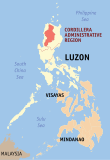
|
Cordillera Administrative Region (CAR) |
14 | Luzon | Baguio | 19,422.03 km2 (7,498.89 sq mi) |
1,791,121 (1.65%) |
89/km2 (230/sq mi) | ||
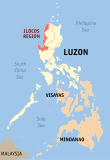
|
Ilocos Region (Region I) |
01 | Luzon | San Fernando | 13,012.60 km2 (5,024.19 sq mi) |
5,292,297 (4.87%) |
386/km2 (1,000/sq mi) | ||

|
Cagayan Valley (Region II) |
02 | Luzon | Tuguegarao | 28,228.83 km2 (10,899.21 sq mi) |
3,679,748 (3.39%) |
122/km2 (317/sq mi) | ||

|
Central Luzon (Region III) |
03 | Luzon | San Fernando | 22,014.63 km2 (8,499.90 sq mi) |
12,387,811 (11.40%) |
510/km2 (1,320/sq mi) | ||
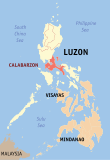
|
Calabarzon (Region IV-A) |
04 | Luzon | Calamba | 16,873.31 km2 (6,514.82 sq mi) |
16,139,770 (14.85%) |
854/km2 (2,213/sq mi) | ||

|
Southwestern Tagalog Region (Mimaropa)[lower-alpha 4] |
17 | Luzon | Calapan | 29,620.90 km2 (11,436.69 sq mi) |
3,212,287 (2.96%) |
100/km2 (259/sq mi) | ||

|
Bicol Region (Region V) |
05 | Luzon | Legazpi | 18,155.82 km2 (7,010.00 sq mi) |
6,067,290 (5.58%) |
319/km2 (827/sq mi) | ||
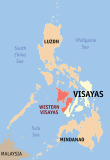
|
Western Visayas (Region VI) |
06 | Visayas | Iloilo City | 20,794.18 km2 (8,028.68 sq mi) |
7,935,531 (7.30%) |
362/km2 (939/sq mi) | ||

|
Central Visayas (Region VII) |
07 | Visayas | Cebu City | 15,487.69 km2 (5,979.83 sq mi) |
8,046,285 (7.40%) |
478/km2 (1,237/sq mi) | ||

|
Eastern Visayas (Region VIII) |
08 | Visayas | Tacloban | 23,251.10 km2 (8,977.30 sq mi) |
4,531,512 (4.17%) |
191/km2 (495/sq mi) | ||
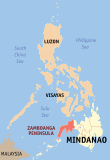
|
Zamboanga Peninsula (Region IX) |
09 | Mindanao | Pagadian | 17,056.73 km2 (6,585.64 sq mi) |
3,862,588 (3.55%) |
213/km2 (551/sq mi) | ||

|
Northern Mindanao (Region X) |
10 | Mindanao | Cagayan de Oro | 20,496.02 km2 (7,913.56 sq mi) |
5,007,798 (4.61%) |
229/km2 (593/sq mi) | ||

|
Davao Region (Region XI) |
11 | Mindanao | Davao City | 20,357.42 km2 (7,860.04 sq mi) |
5,223,802 (4.81%) |
245/km2 (634/sq mi) | ||

|
Soccsksargen (Region XII) |
12 | Mindanao | Koronadal | 22,513.30 km2 (8,692.43 sq mi) |
4,351,773 (4.0%) |
202/km2 (523/sq mi) | ||

|
Caraga (Region XIII) |
16 | Mindanao | Butuan | 21,478.35 km2 (8,292.84 sq mi) |
2,795,340 (2.57%) |
121/km2 (313/sq mi) | ||

|
Bangsamoro (BARMM)[lower-alpha 7] |
19[39] | Mindanao | Cotabato City | 12,535.79 km2 (4,840.10 sq mi) |
4,938,539 (4.54%) |
302/km2 (781/sq mi) | ||
Notes
| |||||||||
Hudisyal na mga rehiyon
[baguhon | baguhon an source]- Para sa a list of these judicial regions, hilingon an Regional Trial Court#List.
Segun sa hudikatura, specifically an enot asin ikaduwang lebel na mga korte, an nasyon binangâ sa hudisyal na mga rehiyon na itinao kan Batas Pambansa Bilang 129. An sakop kan mga these judicial regions na ini sa pankagabsan nag-coincide sa mga administratibong rehiyon kaidtong 1980, na igwa nin ibang mga eksepsyon.
Lehislatibong distrito
[baguhon | baguhon an source]An mga representasyon para sa Interim Batasang Pambansa iyo an kadaklan na sa paagi kan mga parlamentaryong distrito basado sa kun pano an mga rehiyon na inorganisar kaidtong 1978. An Metro Manila iyo an dating "Rehiyon IV", mantang an Habagatan na Tagalog iyo an "Rehiyon IV-A". Iyo ini an solamenteng panahon na an nasyonal na lehislatura iyo an dating rinepresentar via mga rehiyon; sa 1984 plebesito, inaprubaran kan mga botante an pag-amyenda sa konstitusyon na ibalik sa pagrepresentar sa lambang probinsya asin syudad.
Toltolan
[baguhon | baguhon an source]- ↑ Integrated Reorganization Plan: Reorganization of the Executive Branch of the National Government. Presidential Commission on Reorganization. 1972. pp. 12–13.
- ↑ "Presidential Decree No. 224". Retrieved November 5, 2016.
- ↑ "Presidential Decree No. 742; Restructuring the Regional Organization of Mindanao, Basilan, Sulu and Tawi-Tawi". The Lawphil Project. July 7, 1975. Retrieved June 6, 2015.
- ↑ "Presidential Decree No. 1618; Implementing the Organization of the Sangguniang Pampook and the Lupong Tagapagpaganap ng Pook in Region IX and Region XII and for Other Purposes". The Lawphil Project. July 25, 1975. Retrieved June 6, 2015.
- ↑ "Presidential Decree No. 773; Amending Presidential Decree No. 742 Restructuring the Regional Organization of Mindanao and Dividing Region IX into Two Sub-regions". The Lawphil Project. August 21, 1975. Retrieved June 6, 2015.
- ↑ "Presidential Decree No. 824; Creating the Metropolitan Manila and the Metropolitan Manila Commission and for Other Purposes". The Lawphil Project. November 7, 1975. Retrieved June 6, 2015.
- ↑ "Presidential Decree No. 879 – Dividing Region No. 4 of the Administrative Field Organization of the Various Departments and Agencies of the Government Into Region No. 4 and 4-A". Supreme Court E-Library. President of the Philippines. January 23, 1976. Archived from the original on May 16, 2023. Retrieved May 16, 2023.
- ↑ "Presidential Decree No. 1396, s. 1978; Creating the Department of Human Settlements and the Human Settlement Development Corporation, Appropriation Funds Therefor, and Accordingly Amending Certain Presidential Decrees". Official Gazette of the Republic of the Philippines. Archived from the original on March 6, 2018. Retrieved September 22, 2015.
- ↑ "Presidential Decree No. 1555: Further Amending Presidential Decree No. 742 as amended by Presidential Decree No. 773 transferring the regional center of Region IX from Jolo to Zamboanga City". The LawPhil Project. 1978-06-11. Retrieved 2020-06-12.
- ↑ "Executive Order No. 220; Creating a Cordillera Administrative Region, Appropriating Funds Therefor and for Other Purposes". The Lawphil Project. July 15, 1987. Retrieved June 6, 2015.
- ↑ "Republic Act No. 6734; An Act Providing for an Organic Act for the Autonomous Region in Muslim Mindanao". The Lawphil Project. August 1, 1989. Retrieved June 6, 2015.
- ↑ "Republic Act No. 6766; An Act Providing for an Organic Act for the Cordillera Autonomous Region". The Lawphil Project. October 23, 1989. Retrieved June 6, 2015.
- ↑ "Executive Order No. 429 s. 1990; Providing for the Reorganization of the Administrative Regions in Mindanao, and for Other Purposes". The Lawphil Project. October 12, 1990. Retrieved June 6, 2015.
- ↑ "Republic Act No. 7901; An Act Creating Region XIII to be Known as the Caraga Administrative Region, and for Other Purposes". Chan Robles Virtual Law Library. February 23, 1995. Retrieved June 6, 2015.
- ↑ "Republic Act No. 8438; An Act to Establish the Cordillera Autonomous Region". The Lawphil Project. December 22, 1997. Retrieved June 6, 2015.
- ↑ "Republic Act No. 8744; An Act Repealing Section 3 of Republic Act No 7901 and to Return the Province of Sultan Kudarat to Region XII and for Other Purposes". The Lawphil Project. December 18, 1998. Retrieved June 6, 2015.
- ↑ "Republic Act No. 9054; An Act to Strengthen and Expand the Organic Act for the Autonomous Region in Muslim Mindanao, Amending for the Purpose Republic Act No. 6734, Entitled "An Act Providing for the Autonomous Region in Muslim Mindanao," as Amended". The Lawphil Project. March 31, 2001. Retrieved June 6, 2015.
- ↑ "Executive Order No. 36;Providing for the Reorganization of the Administrative Regions in Mindanao and for Other Purposes". The Lawphil Project. September 19, 2001. Retrieved June 6, 2015.
- ↑ "Executive Order No. 103; Dividing Region IV into Region IV-A and Region IV-B, Transferring the Province of Aurora to Region III and for Other Purposes". The Lawphil Project. May 17, 2002. Retrieved June 6, 2015.
- ↑ "Executive Order No. 429; Providing for the Reorganization of Administrative Region VI to Include the Province of Palawan and Puerto Princesa City". The Lawphil Project. May 23, 2005. Retrieved June 6, 2015.
- ↑ "Administrative Order No. 129; Directing the Department of the Interior and Local Government to Hold in Abeyance the Implementation of Executive Order No. 429 (s. 2005) Pending Its Submission of an Implementation Plan and Its Subsequent Approval By the Office of the President". Philippine Statistics Authority. August 19, 2005. Archived from the original on February 19, 2006. Retrieved June 6, 2015. Unknown parameter
|url-status=ignored (help) - ↑ "Executive Order No. 183, s. 2015; Creating a Negros Island Region and for Other Purposes". Official Gazette (Philippines). May 29, 2015. Archived from the original on July 29, 2017. Retrieved June 6, 2015.
- ↑ "An Act establishing the Southwestern Tagalog Region, to be known as the MIMAROPA Region". July 17, 2016. Archived from the original on September 11, 2017. Retrieved January 4, 2017.
- ↑ "BREAKING: President Rodrigo Duterte issues E.O. 38, which revokes the creation of Negros Island Region". CNN Philippines. August 9, 2017. https://twitter.com/cnnphilippines/status/895115929373126656.
- ↑ "Comelec ratifies Bangsamoro Organic Law". BusinessMirror (in English). January 26, 2019. Retrieved February 6, 2019.
- ↑ Depasupil, William; Reyes, Dempsey (January 23, 2019). "'Yes' vote prevails in 4 of 5 provinces". The Manila Times. https://www.manilatimes.net/yes-vote-prevails-in-4-of-5-provinces/500640/.
- ↑ Galvez, Daphne (January 22, 2019). "Zubiri: Overwhelming 'yes' vote for BOL shows Mindanao shedding its history of conflict". Philippine Daily Inquirer. https://newsinfo.inquirer.net/1076036/zubiri-overwhelming-yes-vote-for-bol-shows-mindanao-shedding-its-history-of-conflict.
- ↑ "Bilang kan mga of probinsya, syudad, munisipalidad asin barangay, lambang rehiyon, poon kan 30 Hunyo 2019" (PDF). PSGC. Philippine Statistics Authority. Retrieved August 9, 2019.
- ↑ 29.0 29.1 Republic of the Philippines (1987). "The 1987 Constitution of the Philippines – Article X, Local Government". The Official Gazette of the Republic of the Philippines. Archived from the original on August 10, 2019. Retrieved August 9, 2019.
- ↑ Fidel V. Ramos (April 12, 1996). "Executive Order No. 325, Series of 1996". The Official Gazette of the Republic of the Philippines. Archived from the original on August 11, 2019. Retrieved August 9, 2019.
- ↑ 31.0 31.1 "FAQs – The Regional Development Council" (PDF). National Economic and Development Authority. November 2018. Archived from the original (PDF) on August 11, 2019. Retrieved August 11, 2019.
- ↑ Congress of the Philippines (March 1, 1995). "Republic Act No. 7924 – An Act Creating Metropolitan Manila Development Authority, Defining Its Powers And Function, Providing Funds Therefor And Other Purposes" (PDF). Archived from the original (PDF) on August 10, 2019. Retrieved August 9, 2019.
- ↑ "G.R. No. 93054. December 4, 1990. Cordillera Regional Assembly Member Alexander P. Ordillo, (Banaue), Ifugao Provincial Board Member Corazon Montinig, (Mayoyao), Former Vice Mayor Martin Udan (Banaue), Municipal Councilors Martin Gano, (Lagawe), and Teodoro Hewe, (Hingyon), Barangay Councilman Pedro W. Dulag (Lamut); Aguinaldo Residents Sandy B. Changiwan, and Donato Timago; Lamut Resident Rey Antonio; Kiangan Residents Orlando Puguon, and Reynand Duldulao; Lagawe Residents Tomas Kimayong, Gregorio Dango, George B. Baywong, and Vicente Lunag; Hingyon Residents Pablo M. Dulnuan and Constancio Gano; Mayoyao Residents Pedro M. Baoang, Leonardo Igadna, and Maximo Igadna; and Banaue Residents Puma-a Culhi, Latayon Buttig, Miguel Pumelban, Andres Ordillo, Federico Mariano, Sandy Binomnga, Gabriel Limmang, Romeo Tongali, Ruben Bahatan, Mhomdy Gabriel, and Nadres Ghamang, Petitioners, V. The Commission on Elections; the Franklin M. Drilon, Secretary of Justice; Catalino Macaraig, Executive Secretary; the Cabinet Officer for Regional Development; Guillermo Carague, Secretary of Budget and Management; and Rosalina S. Cajucom, OIC, National Treasurer, Respondents." ChanRobles Law Library. December 4, 1990. Retrieved August 9, 2019.
- ↑ "Provincial Summary Number of Provinces, Cities, Municipalities and Barangays, by Region" (PDF). Philippine Statistics Authority. March 31, 2020. Retrieved May 19, 2020.
- ↑ "PSGC Interactive; List of Provinces". Philippine Statistics Authority. Archived from the original on September 12, 2016. Retrieved April 3, 2016.
- ↑ "PSGC Interactive; List of Cities". Philippine Statistics Authority. Retrieved April 7, 2016.
- ↑ For provinces in the ARMM: "Bangsamoro Development Plan Integrative Report, Chapter 10" (PDF). Bangsamoro Development Agency. 2015. Retrieved May 31, 2016.
- ↑ "Household Population, Number of Households, and Average Household Size of the Philippines (2020 Census of Population and Housing)". Philippine Statistics Authority. May 24, 2022. Retrieved May 24, 2022.
- ↑ "Philippine Standard Geographic Code (PSGC) | Philippine Statistics Authority". psa.gov.ph. Retrieved 2022-06-28.
